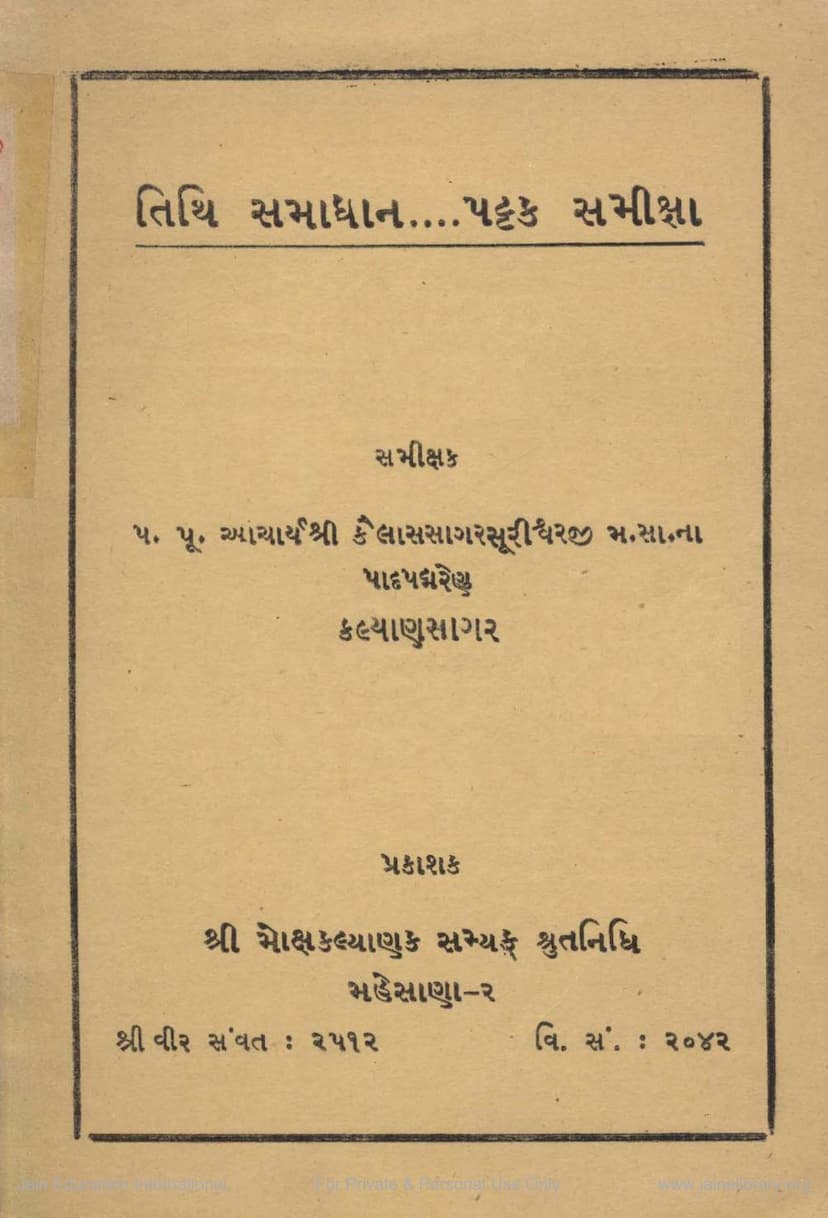Tithi Samadhan Pattak Samiksha
Added to library: September 2, 2025

Summary
Here's a comprehensive summary of the Jain text "Tithi Samadhan Pattak Samiksha" by Kalyansagar, based on the provided pages:
Title: Tithi Samadhan Pattak Samiksha (Review of Calendar Resolution and Sangha Conduct)
Author: Kalyansagar
Publisher: Shri Mokshkalyanak Samyak Shrutnidhi, Mehsana
Date of Publication: Shri Veer Samvat 2512 / Vikram Samvat 2042 (corresponds to approximately 1985-1986 CE)
Core Subject: The book is a critical review and defense of established Jain traditions, specifically regarding the calculation and observance of tithis (lunar days), festivals, and auspicious timings, particularly within the Tapagacch lineage of the Jain Sangh. It addresses a controversy or differing viewpoint that arose regarding the calendar and festival dates.
Key Arguments and Concerns Raised by the Author (Kalyansagar):
-
Defense of the "Janmabhumi Panchang": The author strongly advocates for the "Janmabhumi Panchang" (Birthplace Almanac) as the authoritative calendar used by the Jain Sangh (specifically the Tapagacch). This panchang was officially accepted by the then-leading Acharyas of the Tapagacch in Shri Veer Samvat 2484 / Vikram Samvat 2014, following a request from Seth Kasturbhai Lalbhai. It is used for calculating festival dates, auspicious timings for temple consecrations, initiations, and other significant religious events.
-
Critique of a Contradictory Statement: Kalyansagar expresses deep distress and disagreement with a statement published in the "Gujarat Samachar" newspaper on January 22, 1986 (Shri Veer Samvat 2512 / Vikram Samvat 2042, Paush Sudi Baras). This statement, under the title "Tithi-Samadhan tatha Sangha-Acharane Pattak" (Calendar Resolution and Sangha Conduct Chart), is deemed "nirapeksha" (unrelated/disregarding) of Jain agnya (scriptural injunctions) and therefore "avihit" (improper/unjustified).
-
The Significance of the Tapagacch and its History: The text highlights the historical significance of the Tapagacch, tracing its origin back to Acharya Jagadchandra Surishwarji Maharaj. He was honored with the title "Tapa" (asceticism) by Maharana Jai Singh of Mewar in Vikram Samvat 1285. The author emphasizes the esteemed tradition of asceticism, scholarship, and devotion within the Tapagacch, currently led by Acharya Vijaydevsuriji.
-
The Principle of "Kshaya-Vriddhi" (Reduction/Increase of Tithis): A central point of contention revolves around the handling of kshaya-vriddhi, where a tithi might be omitted or observed for an extra day due to the alignment of lunar and solar calculations.
- The established, "suvihit" (properly established) tradition, following Jina-agnya, states that tithis like Beej, Pancham, Ashtami, Ekadashi, Chaturdashi, Amavasya, and Purnima in both Krishna and Shukla paksha (fortnights) should not be reduced or increased.
- However, when a tithi is reduced, the preceding apra-tithi (non-festival day) is generally increased to maintain the flow of rituals. For example, if Pancham is reduced, Tritiya might be observed for two days.
- The controversy specifically concerns the tithi of Bhadrava Shuddhi Choth and Pancham, related to the Paryushana Mahaparva and Samvatsarik Mahaparva.
-
The "Sixth Tithi" Controversy: The crux of the disagreement appears to be the insistence by some on reducing or increasing the tithi of Bhadrava Shuddhi Chhath (the sixth day of the bright fortnight of Bhadrava).
- Kalyansagar argues that the "Janmabhumi Panchang" correctly does not show a reduction or increase in Bhadrava Shuddhi Chhath this year (V.S. 2512/2042).
- He criticizes the stance of those who insist on reducing Bhadrava Shuddhi Chhath, especially if it means disregarding the "Janmabhumi Panchang" and resorting to other panchangs.
- He argues that such an insistence on reducing Bhadrava Shuddhi Chhath is contrary to the established tradition and Jina-agnya, especially when it involves altering the continuity of Bhadrava Shuddhi Choth (Samvatsarik) and Pancham (part of Paryushan).
- He suggests that this insistence on modifying the Bhadrava Shuddhi Chhath might be driven by a desire to "revive" a previous practice that was already deemed improper.
-
Consequences of Disregarding Tradition: The author warns that deviating from the established traditions and the "Janmabhumi Panchang" creates disunity and deep cracks within the Jain Sangh. He fears that this will lead to severe negative consequences for Jainism.
-
Critique of Unilateral Decisions: Kalyansagar questions the validity of statements made in the newspaper without the explicit consent and consultation of the senior Acharyas of the Tapagacch. He points out the discrepancy in timing between the implementation of the "Tithi Samadhan Pattak" (November 13, 1985) and the publication of the critical statement (January 22, 1986), highlighting that many tithis and observances would have already passed according to the new, contested view.
-
The Importance of Acharya's Commands: The author refers to instances where the Tapagacch Acharyas have refused to associate with individuals or groups who have acted against the Sangh's established practices, demanding micchami dukkaḍam (a prayer for forgiveness) for past transgressions before engaging in dialogue.
-
Call for Adherence and Rectification: The book urges the concerned parties to withdraw their improper statements and to adhere to the established traditions and the "Janmabhumi Panchang." It emphasizes that any deviation from the Jina-agnya and the established practices is a grave matter.
-
Inclusion of Other Tithis: The author also touches upon the general practice of adjusting preceding apra-tithis when festival tithis like Chaturdashi, Purnima, or Amavasya are reduced, to maintain continuity. He questions why this principle, when applied to Bhadrava Shuddhi Tritiya in relation to Choth and Pancham, is being bypassed in favor of modifying the Chhath.
Overall Tone: The book is written with a tone of deep concern, conviction, and urgency. Kalyansagar presents his arguments with meticulous detail, drawing upon historical precedent and established Jain principles, to defend the traditional calendar system and the authority of the Jain Sangha's leadership against what he perceives as a detrimental deviation. He expresses sorrow and a sense of duty to uphold the sanctity of Jain traditions.